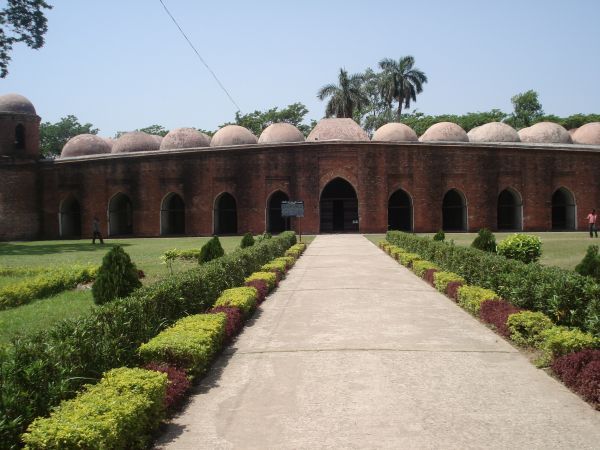_005.jpg)
Sixty Dome Mosque An ancient mosque situated in the southwest of Bagerhat district of Bangladesh. There is no inscription on the mosque. So no accurate information is available about who was created or at what time it was built. But there is no doubt about the architecture of the mosque that Khan-i-Jahan had built. It is believed that he built it in the 15th century. This mosque was built for many years and with a lot of money. The stones were brought from Rajmahal It is located in one of the three world heritage sites of Bangladesh; The city of Bagerhat has been given the status of World Heritage Site. In 1983, UNESCO gave this honor.
The mosque is about 160 feet in the north-south direction and about 143 feet long in the interior and about 104 feet on the east-west side and about 88 feet wide in the interior. The walls are about 8 feet thick.
History
Part of a series
Mosque
Architecture
List
[Show]
Architectural Style
List
[Show]
Mosque List
List
[Show]
Other
List
[Show]
This box:
Show conversation edit
During the reign of Sultan Nasiruddin Mahmud Shah (1435-59), Khan al-Azam Ulug Khan Jahan established the state of Khalifabad in the jurisdiction of Sundarbans. Khanjahan set up a court hall for the meeting, which later became the sixty-dome mosque. [1] The mosque was built for many years and with a lot of money. The stones were brought from Rajmahal The construction style of Tughlaqi and Johanpuri is obvious.
Outdoors
The mosque has 11 large enclosure doors on the eastern wall. The middle door is bigger than the others. The north and south walls have 7 doors. There are 4 monuments in the 4 corners of the mosque. Their design is round and they are narrowed upwards. They have horny bands and rounded dome with corners. The height of the monuments, more than the rooftop cornice. There are two stairs on the front and there are arrangements for Ajan. One of them is named Raushan Kotha, and the other is named as Indore Kotha. There are 60 pillars or pillars inside the mosque. They are located in 6 rows from north to south and there are 10 pillars in each row. Each stone is cut into stone, only 5 pillars have been covered with bricks from outside. This dome is made on 60 pillars and surrounding walls. The name of the mosque is sixty dome (60 dome) mosque, but the dome here is not 60, but the number of dome is 77. Seven domes in the row between 70 dome between the 77 dome and between the middle of the eastern wall and the mihrab between the west wall is very much like the chawkala house rice in Bangladesh. The number of domes in the minaret is 4, and the number of domes stands at 81. Yet its name is Shatgumba. Historians believe that there are seven dome rows, seven dome of this mosque and the name of sixty-two beam is named. Again, many historians believe that the dome is located on 60 stone pillars, so that the name is sixty-five. [2]. [3]
There are 10 mihrabs on the western wall inside the mosque. The middle mihrab is big and shapely in shape. There are 5 mihrabs in the south and 4 mihrabs in the north. Just next to the middle of the mihrab, on the north side, where there is one mihrab, there are 1 small door. According to some, Khan-i-Jahan used this mosque as a darbar house apart from the work of Salat, and this door was the entrance to the court room. Some people say that the mosque was also used as a madrassa. There is a place named as Emam's place for sitting.
Good!
Downvoting a post can decrease pending rewards and make it less visible. Common reasons:
Submit